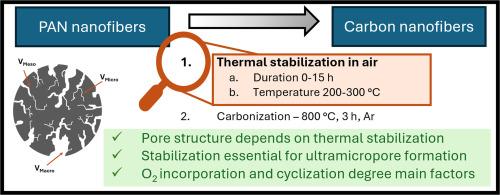The impact of thermal stabilization temperature and duration on the pore structure of polyacrylonitrile-based carbon nanofibers
IF 3.9
Q2 MATERIALS SCIENCE, MULTIDISCIPLINARY
引用次数: 0
Abstract
This work analyzes the impact of temperature and duration during thermal stabilization of polyacrylonitrile-based (PAN-based) nanofibers on the pore formation of carbon nanofibers. Two sample series at different stabilization durations (0–15 h) and temperatures (200–300 °C) were synthesized and characterized by Fourier-transform infrared spectroscopy, Raman spectroscopy, elemental analysis, solid state nuclear magnetic resonance and gas adsorption. A significant increase of the pore volume of the carbonized nanofibers from 0.039 cm³ g−1 to 0.171 cm³ g−1 was obtained for long stabilization durations (> 4 h). Similar increases up to 0.166 cm³ g−1 were obtained at high stabilization temperatures (> 250 °C). This increased pore formation was assigned to the growth of larger stabilized ladder polymers and a high incorporation of oxygen during the thermal stabilization at these conditions. Both alter the structure of the final carbon nanofibers and strongly affect the formation of pore volume during carbonization. Especially, the formation of the ultramicropore volume was found to be highly dependent on these parameters. The results show the necessity of a careful consideration of the thermal stabilization conditions for tailoring of the pore structure of PAN-based carbon nanofibers.

热稳定温度和持续时间对聚丙烯腈基纳米碳纤维孔结构的影响
本文分析了聚丙烯腈基(pan)纳米纤维热稳定过程中的温度和持续时间对碳纳米纤维孔隙形成的影响。合成了两个稳定时间(0-15 h)和温度(200-300℃)不同的样品系列,并通过傅里叶变换红外光谱、拉曼光谱、元素分析、固态核磁共振和气体吸附对其进行了表征。在长稳定时间(> 4 h)下,碳化纳米纤维的孔体积从0.039 cm³g−1显著增加到0.171 cm³g−1。在高稳定温度(> 250°C)下,获得了高达0.166 cm³g−1的类似增加。这种增加的孔隙形成归因于在这些条件下热稳定过程中更大的稳定阶梯聚合物的生长和高氧的掺入。两者都改变了最终碳纳米纤维的结构,并强烈影响炭化过程中孔隙体积的形成。特别是,发现超微孔体积的形成高度依赖于这些参数。结果表明,在设计聚丙烯腈基碳纳米纤维的孔结构时,需要仔细考虑热稳定条件。
本文章由计算机程序翻译,如有差异,请以英文原文为准。
求助全文
约1分钟内获得全文
求助全文
来源期刊

Carbon Trends
Materials Science-Materials Science (miscellaneous)
CiteScore
4.60
自引率
0.00%
发文量
88
审稿时长
77 days
 求助内容:
求助内容: 应助结果提醒方式:
应助结果提醒方式:


